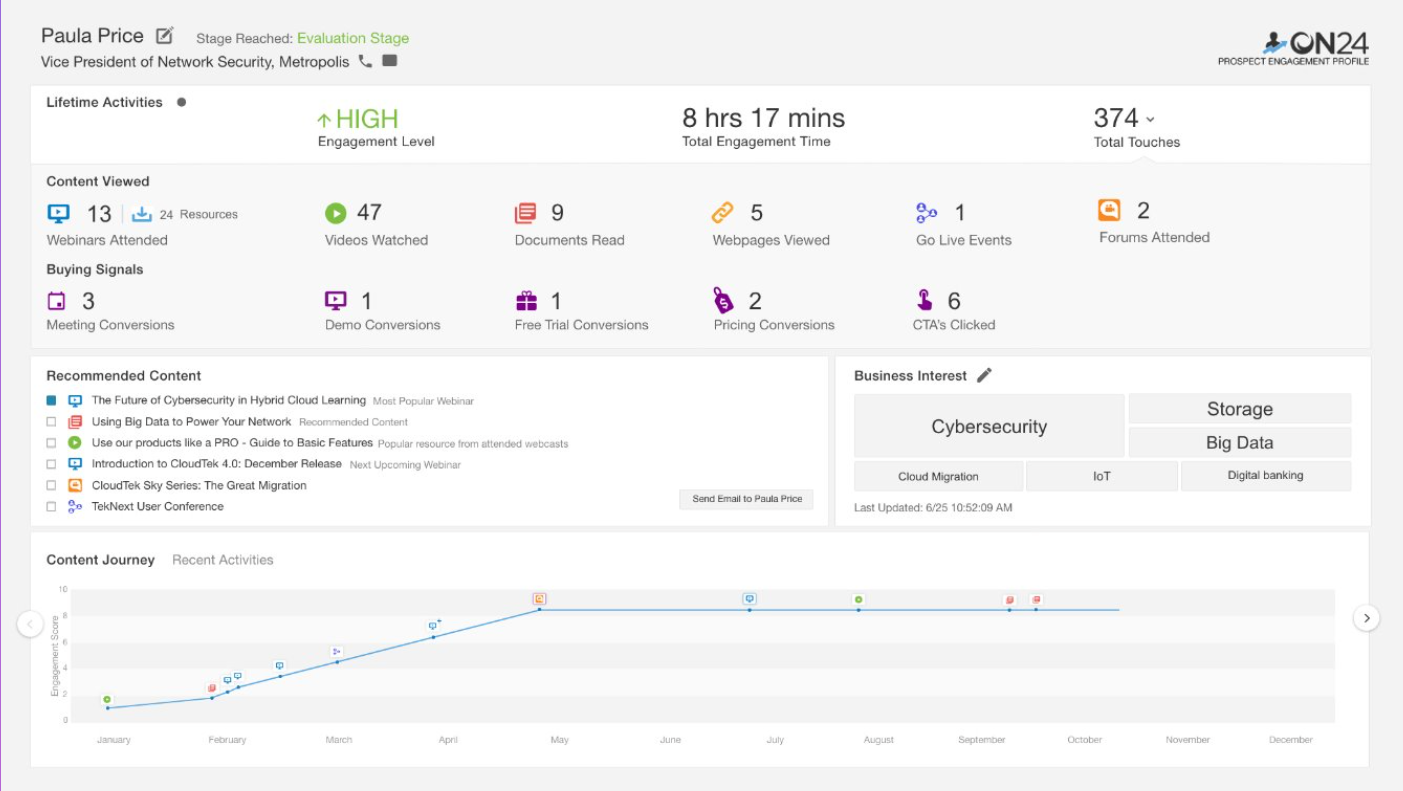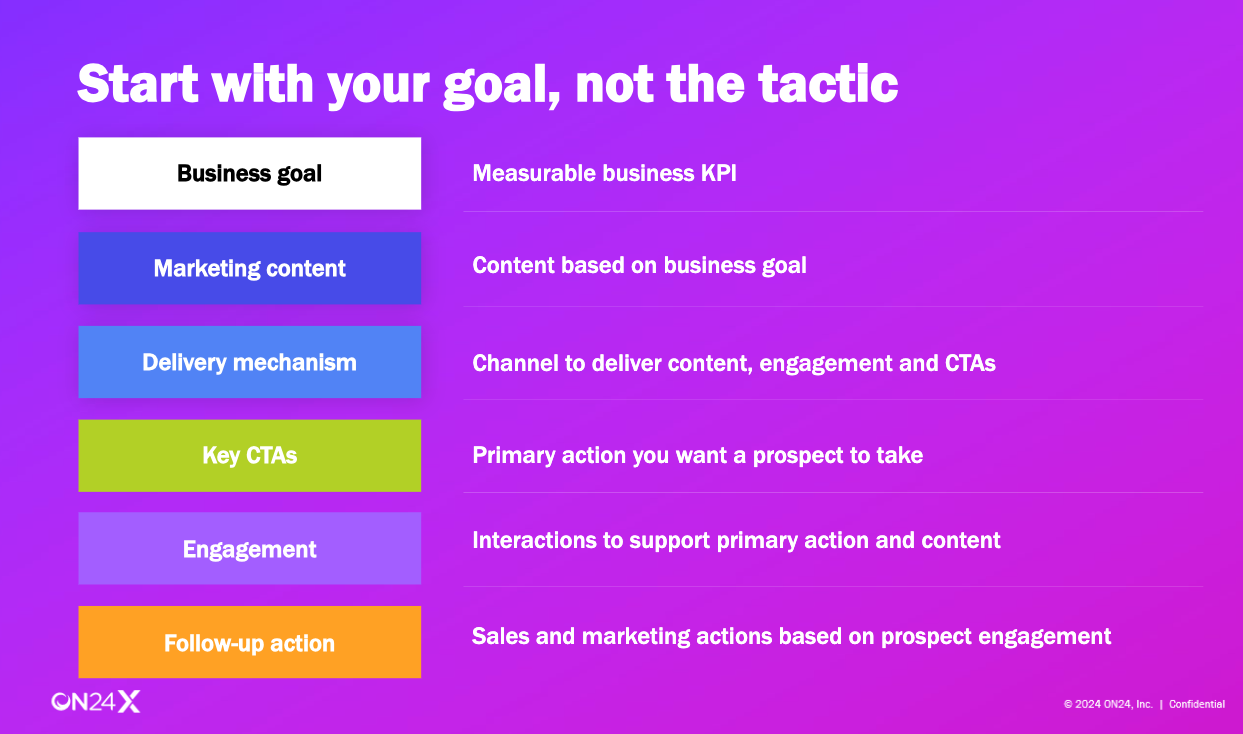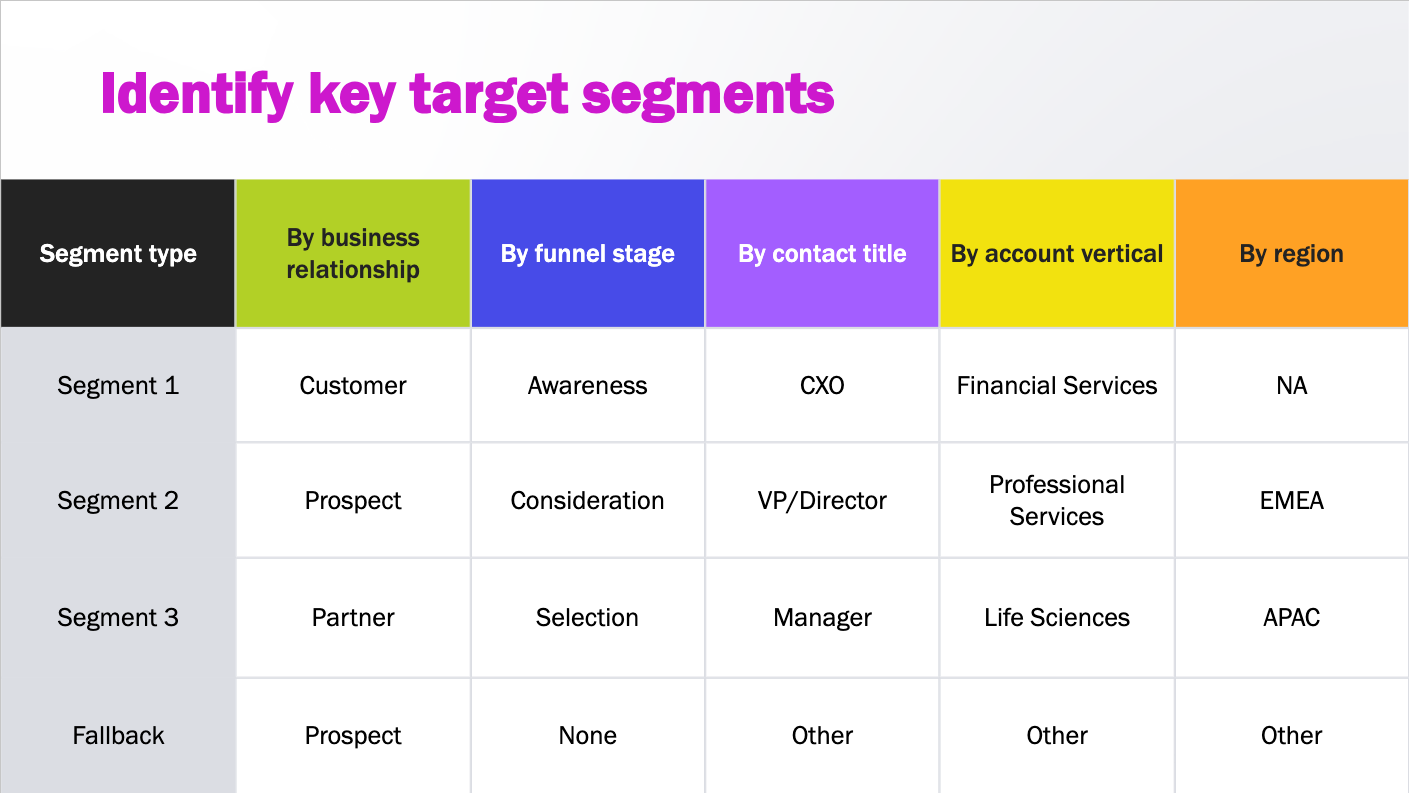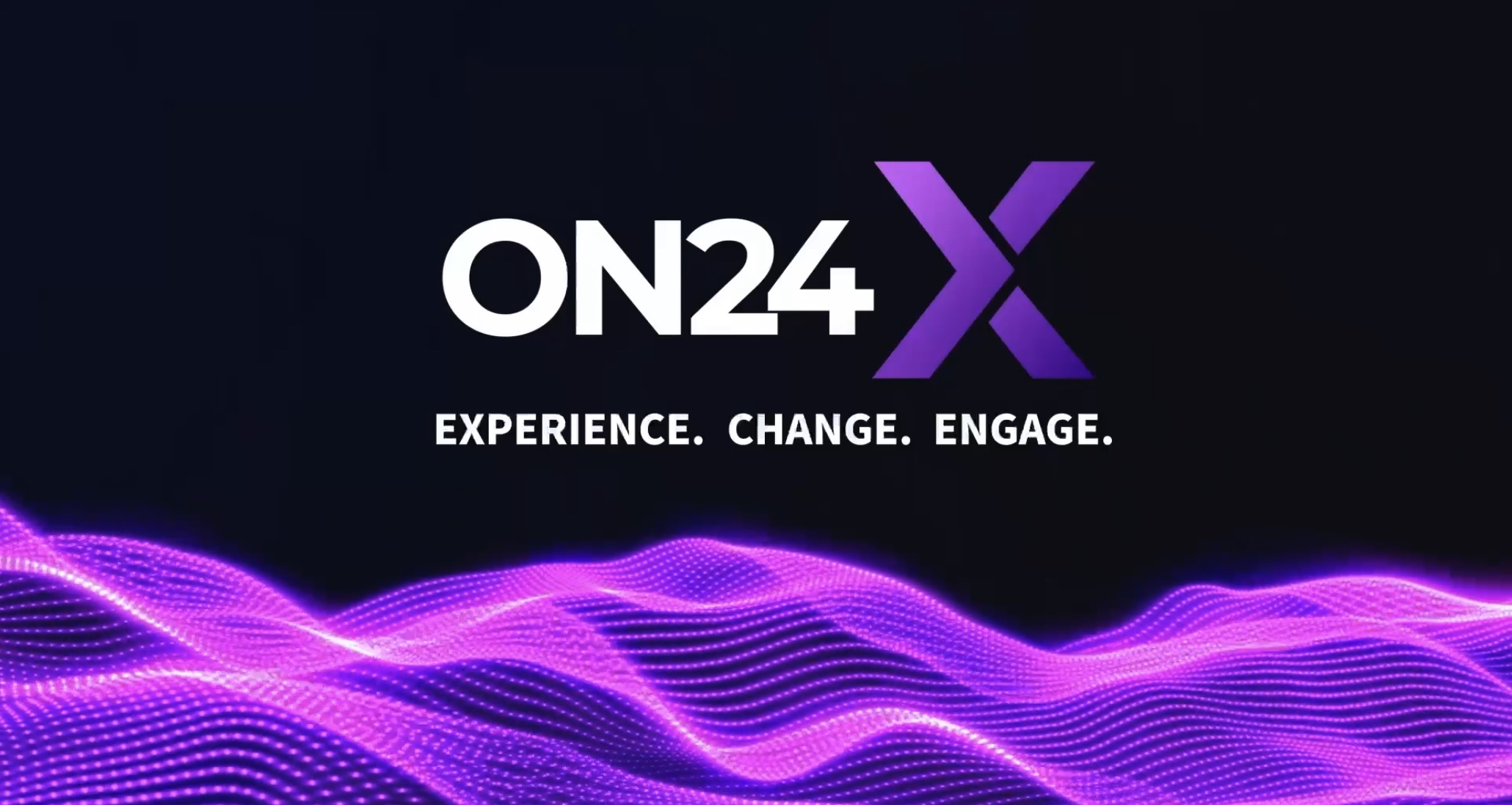Reimagining Engagement: Creating Hyper-Personalized Audience Journeys

For B2B marketers, the ability to personalize experiences has come a long way in a short amount of time. New innovations in generative AI, and various other artificficial intelligence tools, has made it possible to segment and hyper-target specific audiences while creating content at scale.
But how can a busy marketer make the dream of hyper-personalized experiences a reality? Mark Bornstein, Vice President of Marketing at ON24, gave marketers a roadmap to driving personalization at scale during the ON24 Experience 2024. Here’s what he had to say:
The importance of webinars

Before diving into personalization, it’s important to understand the why webinars are so important in any B2B marketing mix. In a time when loads of companies are vying for the attention of customers and buyers, webinars present a unique opportunity for marketers to not only engage a large audience all at once, but to also learn a lot about attendees.
Savvy marketers are always looking for ways to generate first-party data and webinars are a goldmine for that kind of data. But that’s only true if you find ways to build in plenty of opportunities for engagement.
Audiences want to interact during digital events
Audiences today prefer interactive and engaging experiences over static content. According to Bornstein, “[Audiences] don’t want to read your 20-page white paper, they don’t want to sit and watch somebody’s endless video. They want to talk”
Webinars, when done right, are exactly what audiences are craving. The wide range of interactive tools now available on the ON24 Intelligent Engagement Platform have become tried-and-tested means of keeping audiences engaged during webinars. They also serve as an excellent source of data and audience insights.
Webinar technology has evolved even further to allow audiences to interact in more direct ways. Participants can now chat with each other during webinars, ask questions of speakers and join virtual breakout rooms where they are encouraged to interact and network with their peers.
Not just for lead generation anymore
Webinars are still an excellent way to generate leads. In fact, webinars are one of the top pipeline-generating channels for many companies. However, their use doesn’t stop at the top of the funnel. Successful brands are now creating webinars to appeal to audiences across the entire buying cycle. This includes creating serialized webinars such as the ON24 Marketing Best Practices Series hosted by Bornstein.
Challenges with Scaling Webinars

Companies are creating more targeted webinars for unique audiences. But as they try to cater to very specific niches within targeted groups, there comes a point when the webinar can no longer scale.
While Bornstein encourages companies to continue to create targeted webinars, he stresses that one size does not fit all even within specific targeted cohorts. This means that marketers need to rethink engagement to cater to diverse personas within these groups.
So, how can webinars be scaled? During an ON24 webinar with Workiva, Covington & Burling and Slack, these strategies were suggested:
-
- Set up regional teams to launch and rerun existing webinars: Set regions up for success by providing a “webinar kit” which contains the webinar presentation, easily convertible or updated advertising and an example abstract that can be adapted.
- Drive on-demand views and engagement with content hubs and paid advertising: Content hubs allow audiences to self-serve content when it’s most convenient for them, making it possible for companies to continuously engage with audiences even after the live webinar has occurred. Additionally, paid ads and social media helps to drive audiences to on-demand content they might otherwise not have known about.
- Repurpose content with AI: Get the most out of your webinars by using AI to summarize events, create personalized follow-up and generate additional content such as blog posts and e-books.
Building engaging webinars

Before marketers start personalizing, they need to focus on building webinars with plenty of engagement. By driving engagement, you generate first-party data, which converts into pipeline and, eventually, revenue. Bornstein outlines three things to keep in mind when building and optimizing webinars for maximum engagement.
- Audience participation: Remember, audiences don’t want to just sit there and watch a webinar with people talking at them. They want to take an active part in webinars — whether it is through asking questions, chatting with peers, browsing through content or sending their reactions when they hear something that sparks their curiosity.

- Engagement metrics: While many companies use attendance as a metric to determine the success of their webinars, whether someone shows up for a webinar doesn’t provide much insight into your audience. Instead, Bornstein advises:
“The goal of your webinars is engagement. It’s to see how much you can get your audience to interact with you and to engage with you in every single experience. That is how you will learn more about them.”
By looking at what questions participants are asking, how they answer specific poll questions and what content they choose to download are strong indicators of where they are in the buying cycle and if they are ready to be approached by sales.

- Business goals: Make sure that you’re creating every webinar with business goals in mind. Each webinar should have a primary KPI but also secondary CTAs that cater to different audience readiness levels. For example, if the goal of your webinar is to book a certain number of meetings, the primary CTA would center around something like “Are you ready to chat?” However, some in your audience may not be ready to speak to sales so a secondary CTA might be to have them register for an upcoming webinar or download your latest e-book.
It’s about building a map of engagement, which will indicate what actions marketing or sales will take next with the individual.
Scaling for the many, personalizing for the one

By now, marketers are aware of the effect personalization has on marketing and connecting with prospects and customers, but do you know how personalization impacts webinars? Here are just a few stats to illustrate what personalizing webinars can do per the ON24 2024 Digital Engagement Benchmarks report:
-
- 68% life in calls-to-action engagement
- 4X increase in demo requests within personalized experiences
- 2X conversion rate for meeting bookings within personalized experiences
Overall, personalizing webinars leads to better engagement data which leads to better marketing outcomes and more informed sales outreach.
Personalization strategies
There are a couple ways to personalize content and webinars. The first is strategic personalization, which is based on segmenting along predetermined criteria, such as region, funnel stage or vertical. The table below is an example of how marketers can segment target audiences for better personalization.

Behavioral personalization, on the other hand, is based on past behaviors or engagement history. This could include how many webinars a person has attended in the past and how they engaged during those webinars and what content they downloaded.
The good news is, no matter which strategy you choose to personalize, you no longer have to create separate webinars to cater to each segment. You can personalize for many different audiences within one webinar. Here are a few examples of how it can be done:
-
- Personalize calls-to-action by funnel stage by offering something like a beginner’s guide e-book for those at the top of the funnel, while encouraging those in the middle to sign up for a customer speaker event or bottom-of-funnel attendees to book a meeting.
- Curate relevant life sciences content for specialists and practice area segments. While your life sciences webinar covering a new treatment may include specialists from various medical disciplines such as cardiology, oncology and endocrinology, you will want to prepare content that appeals to each of those specialties.
- Professional services companies, such as a global insurance company, might choose to personalize webinar offerings by region by providing an option at login for attendees to select their regions. They can then be offered content and engagement options pertinent to their region.
Transforming webinars with personalization

With advances in technology, the potential to personalize your digital events has opened up. Marketers no longer need to sacrifice their ability to scale webinars in order to personalize them for specific audiences.
Now is the time to revamp your webinar strategy and adopt this new way to personalize so that you, too can drive engagement and accelerate the buyer’s journey. 